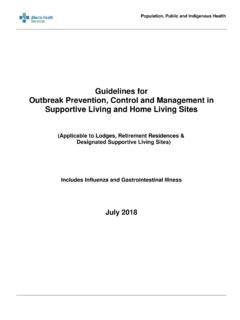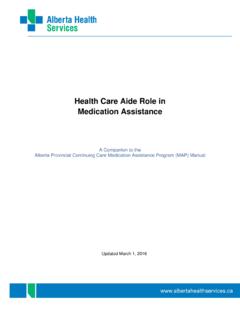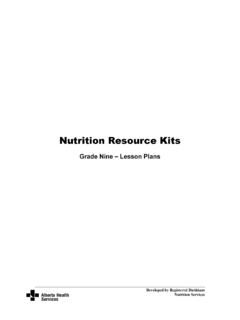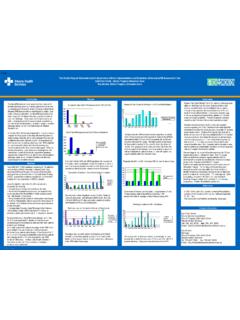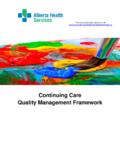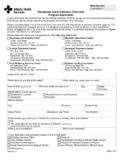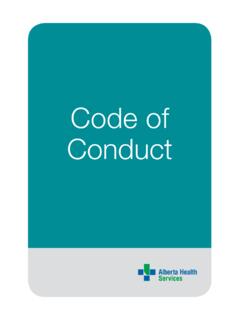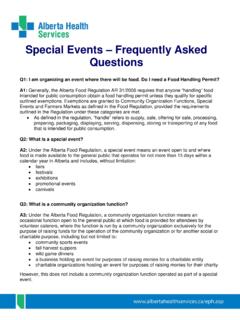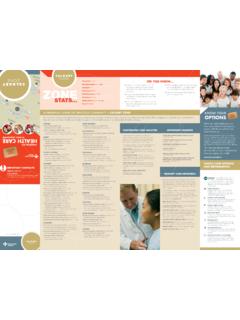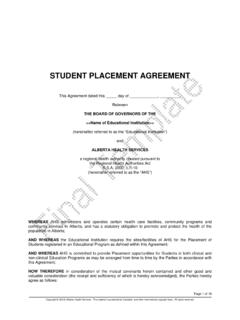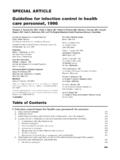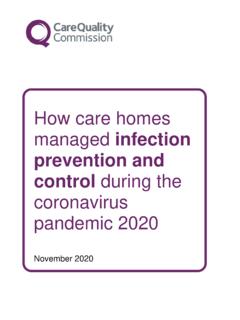Transcription of Interim IPC Recommendations during COVID-19
1 For more information contact 2022 Alberta Health Services, IPC Version Date (YYYY-MM-DD) Created 2020-03-13 Updated 2021-06-15 Revised 2022-03-22 ECC Approved 2022-03-22 In addition to Routine Practices This work is licensed under a Creative Commons Attribution-Non-commercial-Share Alike International license. The license does not apply to AHS trademarks, logos or content for which Alberta Health Services is not the copyright owner. Disclaimer: This material is intended for general information only and is provided on an "as is", "where is" basis. Although reasonable efforts were made to confirm the accuracy of the information, Alberta Health Services does not make any representation or warranty, express, implied or statutory, as to the accuracy, reliability, completeness, applicability or fitness for a particular purpose of such information. This material is not a substitute for the advice of a qualified health professional. Alberta Health Services expressly disclaims all liability for the use of these materials, and for any claims, actions, demands or suits arising from such use.
2 Assessment and screening Acute Care Follow AHS Directive Communicable Disease (Respiratory Including COVID-19 and ILI) Screening, Assessment, and Monitoring In Acute Care and Implementation Strategy: Patient Screening and Symptom Assessment & Monitoring Recommendations for COVID-19 . The acute care testing and additional precautions strategy is summarized in AHS Acute Care COVID-19 Expanded Testing Algorithm. All patients (Admitted Inpatients, Emergency Department [ED], Surgery, Obstetrics, Inter-Facility Transfers, Direct Admissions) except neonates are to be assessed initially for symptoms and risk factors associated with respiratory communicable disease using Communicable Disease (Respiratory) Initial Screening, Form# 21615. The AHS Acute Care COVID-19 Expanded Testing Frequently Asked Questions is available as a guide to the algorithm and assessment tools. Ongoing assessment of admitted patients is to be completed using COVID-19 Symptom Identification and Monitoring, Form# 21616.
3 Ambulatory Care (stand alone or part of an Acute Care site) The ambulatory care testing and additional precautions strategy is summarized in AHS COVID-19 Expanded Testing Algorithm For All Ambulatory Care/OPD Patients in Ambulatory Care and Outpatient Department [OPD], are to be assessed using the Ambulatory Communicable Disease Screening, Form# 21666. Continuing Care COVID-19 Continuing Care Health Assessment Screening Tool is available on Continuing Care Connections for Continuing Care residents. Patients transferred to Continuing Care are to be assessed using Client Admission Screening Tool, Form# 21722. See active Chief Medical Officer of Health Orders for further direction about the COVID-19 response in licensed supportive living, long term care and hospice settings. Primary Care Patients in Primary Care are to be assessed using the Community Physician COVID-19 Screening and Testing Algorithm. See PPE Table for Community Providers/Clinics during COVID-19 (Non-virtual appointments) for personal protective equipment Recommendations .
4 Severely Immunocompromised Patients For the purposes of COVID-19 IPC-related patient management, special consideration is given to a subset of immunocompromised patients who are considered severely immunocompromised. Interim IPC Recommendations during COVID-19 Interim IPC Recommendations during COVID-19 | 2 For more information contact 2022 Alberta Health Services, IPC Version Date (YYYY-MM-DD) Created 2020-03-13 Updated 2021-06-15 Revised 2022-03-22 ECC Approved 2022-03-22 Severely immunocompromised patients may produce replication-competent SARS-CoV-2 virus for prolonged periods beyond 21 days after COVID-19 symptom onset (or after first positive COVID-19 test if asymptomatic throughout). This list is considered current to the date provided, and helps to identify which patients need further discussion with IPC regarding COVID-19 management ( , clearing of COVID-positive status, cohorting when recovered, re-testing within 90 days of initial infection, etc.)
5 Discontinuation of Modified Respiratory P recautions for Suspected or Confirmed COVID-19 in Acute Care For all patients on Modified Respiratory P recautions for suspected or confirmed COVID-19 in Acute Care, use Discontinuation of Modified Respiratory Precautions for Suspected or Confirmed COVID-19 , Form# 21624. For patients in Critical Care, see also Discontinuation of Precautions for Suspected and Confirmed COVID-19 Patients in Critical Care For severely immunocompromised patients, see also IPC Management of Severely Immunocompromised COVID-19 Patients Reinfection and Repeat Positive COVID-19 Test Results Repeat positive COVID-19 tests after a confirmed patient s symptoms have resolved may represent ongoing shedding of non-viable virus that does not pose a transmission risk. If patient is presenting with positive test after resolution of symptoms, consult with IPC regarding requirements for ongoing additional precautions. However, with the emergence of the Omicron variant, repeat COVID-19 testing may be warranted for resolved (cleared) patients within 90 days of the initial positive test result if new symptoms develop.
6 O This is because previous recent infection with other COVID-19 variants confers minimal protective immunity to the Omicron variant. o Testing/investigations for other pathogens/etiologies should also be performed based on clinical/symptom and risk factor assessment, and setting. Contact IPC for more information. Medical Officer of Health (MOH) notification MOH will be notified by Alberta Precision Lab (APL) of presumptive and confirmed positive results. Contact tracing and follow-up will be guided by AHS Zone Public Health. In acute care facilities, this is in collaboration with IPC. AHS Updates. Laboratory testing for COVID-19 Nasopharyngeal (NP) swab or throat swab Asymptomatic individual o If asymptomatic testing is being done in a centralized location, follow IPC Recommendations PPE Table for Assessment Centres during COVID-19 . o If decentralized swabbing ( , going into individual s room or bedspace), then all PPE is to be changed between each patient encounter.
7 Symptomatic individual o Fit tested N95 respirator (may use procedure/surgical mask based on PCRA*), eye/face protection, gown, and gloves are to be worn ( symptomatic patients should be on Modified Respiratory Precautions). *PCRA = Point-of -Care Risk Assessment See updated Joint Statement. There may be situations where a healthcare worker, based upon their Point-of -Care Interim IPC Recommendations during COVID-19 | 3 For more information contact 2022 Alberta Health Services, IPC Version Date (YYYY-MM-DD) Created 2020-03-13 Updated 2021-06-15 Revised 2022-03-22 ECC Approved 2022-03-22 Risk Assessment (PCRA) or their assessment of all known and foreseeable risks and hazards, may choose to wear a medical mask instead of an N95 respirator. o Change all PPE after swabbing each individual. (Exception: A t assessment centre and from same family/household.) Nasal swabs (for point-of -care testing) When indicated, nasal swabs are typically collected from asymptomatic healthcare workers (HCWs) in a centralized location.
8 Use continuous masking and eye protection as per the Personal Protective Equipment Frequently Asked Questions (PPE FAQ). Change mask/respirator and eye protection as a unit if one or both is contaminated or visibly soiled. Refer to lab bulletins for specimen handling, testing and notification for updates. APL will coordinate testing requests. Accommodation Acute Care and Other Non-Continuing Care Settings When determined by AHS Acute Care COVID-19 Expanded Testing Algorithm or other assessment form, place patient in a single room and implement Modified Respiratory Precautions. Use fit tested N95 respirator or procedure/surgical mask based on Joint Statement and PCRA. o There may be situations where a healthcare worker, based upon their Point-of -Care Risk Assessment (PCRA) or their assessment of all known and foreseeable risks and hazards, may choose to wear a medical mask instead of an N95 respirator. Modified Respiratory Precautions sign visible on entry to room or bedspace.
9 O Single room with hard walls and door - i f cohorting is necessary, follow IPC Cohorting Recommendations for COVID-19 in Acute Care. Contact IPC if single or cohorted space is not available. o Follow IPC Recommendations for Cohorting Inpatients on Additional Precautions in Acute Care Facilities after admission, if cohorting is required. o For Aerosol Generating Medical Procedures (AGMP), see below. o In ambulatory care/outpatient areas (including the Emergency Department), bathrooms may need to be shared regardless of whether patients are on Modified Respiratory Precautions. Cohorting Recommendations will evolve as new scientific evidence emerges. o See Patient Cohorting for COVID-19 (Including Variant Strains) memo for more detailed guidance. Continuing Care Modified Respiratory Precautions sign- Continuing Care visible on entry to room or bedspace. o For Aerosol Generating Medical Procedures (AGMP), see below. Cohorting Recommendations will evolve as new scientific evidence emerges.
10 O Congregate Living Settings - Recommendations for Cohorting Clients for more specific guidance. o Congregate Living Settings - Recommendations for Staff Cohorting. Interim IPC Recommendations during COVID-19 | 4 For more information contact 2022 Alberta Health Services, IPC Version Date (YYYY-MM-DD) Created 2020-03-13 Updated 2021-06-15 Revised 2022-03-22 ECC Approved 2022-03-22 Asymptomatic patients with risk factors Emergency and Inpatient Areas (includes residents admitted from congregate living sites with COVID-19 outbreak). As quickly as possible place patient in a single room and implement Modified Respiratory Precautions in addition to Routine Practices. o Use fit tested N95 respirator or procedure/surgical mask based on Joint Statement and PCRA. o There may be situations where a healthcare worker, based upon their Point-of -Care Risk Assessment (PCRA) or their assessment of all known and foreseeable risks and hazards, may choose to wear a medical mask instead of an N95 respirator.
